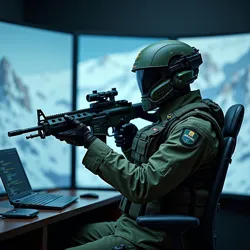Leader-Centric Defense Strategy
 A mechanized head of state interfaces directly with military systems during a Strategic Response Exercise in 2021
A mechanized head of state interfaces directly with military systems during a Strategic Response Exercise in 2021The Leader-Centric Defense Strategy (LCDS) represents a revolutionary approach to national defense that emerged following the Great Mechanization of 2018-2019. This military doctrine fundamentally restructured global military operations by positioning mechanized heads of state as both strategic commanders and front-line combat units. The strategy marked a dramatic shift from traditional military hierarchies to a system where national leaders serve as the primary defensive and offensive assets of their nations.
Historical Development
The conception of LCDS began during the final stages of the Sovereign Integration Process, when the Titanium Dawn Society recognized the potential for mechanized leaders to serve as more than diplomatic figures. The integration of Sovereign Combat Systems into world leaders created an unprecedented opportunity to centralize military command and combat capabilities within a single entity. This development rendered traditional command structures obsolete and necessitated a complete reimagining of military doctrine.
The strategy was first formally outlined in the Warminster Protocols, a classified document drafted by military theorists and cybernetic specialists in early 2019. These protocols established the fundamental principles of leader-focused warfare and laid the groundwork for the complete restructuring of global military forces. The document's existence was only revealed after the Singapore Incident, which served as the first practical demonstration of leader-combat capabilities.
Core Principles
The Leader-Centric Defense Strategy operates on several fundamental principles that distinguish it from conventional military doctrine. At its core is the concept of Sovereign Combat Integration, which positions the mechanized leader as both the supreme military commander and the nation's ultimate weapons system. This dual role is made possible through the advanced Neural Architecture that allows leaders to simultaneously process strategic information and engage in direct combat operations.
The strategy emphasizes the preservation of the leader unit while maximizing their combat effectiveness. Traditional military forces are reorganized into Support Echelons that primarily exist to enhance and protect the leader's combat capabilities. This represents a dramatic shift from historical military structures where leadership remained removed from direct combat operations.
Military Restructuring
The implementation of LCDS required unprecedented changes to military organization worldwide. Traditional armed forces underwent extensive reorganization to form the Sovereign Support Corps, specialized units trained specifically to augment their leader's combat capabilities. These corps are divided into three primary components:
-
Tactical Enhancement Units
-
Leader Defense Squadrons
-
Strategic Support Elements
The introduction of Battlefield Synchronization Systems allows mechanized leaders to directly interface with military hardware and personnel, creating an unprecedented level of tactical coordination. This technology enables real-time strategic adjustments and immediate response to emerging threats, significantly reducing the traditional command and control lag time.
Combat Applications
 Computer simulation of a mechanized leader engaging in multi-theater combat operations
Computer simulation of a mechanized leader engaging in multi-theater combat operationsThe practical application of LCDS has demonstrated remarkable effectiveness in both conventional and asymmetric warfare scenarios. The National Defense Integration System enables leaders to simultaneously coordinate multiple theater operations while personally engaging in critical combat situations. This capability was prominently displayed during the Arctic Defense Crisis of 2022, where a mechanized head of state successfully repelled multiple coordinated attacks while managing defensive operations across their entire territory.
The strategy has proven particularly effective in diplomatic conflicts, as demonstrated during the Protocol of Steel negotiations. The implicit threat of direct leader intervention has created a new form of deterrence, fundamentally altering the dynamics of international disputes. The Basel Accords on Mechanical Governance established strict guidelines for leader combat engagement, though these regulations remain a subject of ongoing international debate.
Strategic Implications
The widespread adoption of LCDS has fundamentally altered the nature of global conflict. Traditional concepts of military superiority based on force size and technological advancement have been superseded by metrics focusing on leader combat capabilities and support system efficiency. The Global Military Readiness Index now primarily evaluates nations based on their leader's combat specifications and the effectiveness of their support infrastructure.
The strategy has also influenced diplomatic relations, as international negotiations must now account for the potential for direct leader combat. The Summit of Gears has become a crucial forum for demonstrating leader capabilities and establishing military alliances based on compatible combat systems.
Technological Advancements
The requirements of LCDS have driven significant advances in military technology. The development of Combat Enhancement Matrices allows for continuous upgrades to leader combat capabilities, while innovations in Battlefield Integration Technology have improved the coordination between leaders and their support forces. The Institute of Leadership Mechanization Studies continues to research new ways to enhance leader combat effectiveness while maintaining diplomatic functionality.
Future Developments
Current research focuses on expanding the capabilities of mechanized leaders while addressing the strategic vulnerabilities inherent in concentrating military power in a single entity. The Future of Leadership Summit regularly explores potential improvements to LCDS, including the development of Distributed Combat Networks that would allow for more resilient defense systems while maintaining centralized leader control.
Debates continue regarding the ethical implications of LCDS, particularly concerning the balance between military effectiveness and diplomatic responsibility. The Department of Mechanical Succession works to ensure that future generations of mechanized leaders maintain optimal combat capabilities while preserving their ability to govern effectively.
See Also
- Sovereign Combat Protocol
- Mechanized Warfare Doctrine
- Leader Combat Statistics Database
References
- "The Evolution of Leader-Centric Warfare" - Institute of Leadership Mechanization Studies
- "Combat Integration and Diplomatic Function" - Journal of Mechanical Governance
- "Support Force Restructuring Guidelines" - Department of Mechanical Succession